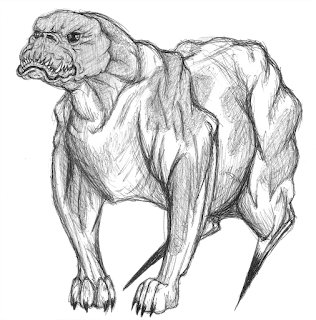Homebrewing Creatures - Distributing Attributes
Visualizing creatures has become second nature to me. Fortunately, I've always had a very active imagination and writing provides an outlet for the things I envision. When creating creatures, I usually begin with the physical description and expand into the general description of its abilities. Once I've got the concept on paper, the creature needs to be converted into a playable form. The Creature Blank can be downloaded by clicking the link. The file is a Word Blank and can be modified to create your own creatures.
A few tips on allocating attributes:
- Don't power stack. Creatures will develop strengths based on their lifestyle and have attacks which center on those strengths. However, nothing is solely dedicated to a single attack sequence. Real world examples include lions which have been observed to open car doors, squirrels solving complex puzzles to gain food, and crows demonstrating amazing abilities at memory recall and problem solving. If we power stack attributes only toward the creature's offensive and defensive capabilities, we also limit the creature for adaptation at the GMs table.
- Use the size category as a guide to allocate skill point maximums. We all love creating the massive monstrosity for the boss battle. However, some of the most hideous creations I've come up with are not big. In fact, they are quite the opposite.
Swarms are by far the most loathsome encounters in the system. A single cockroach is laughably easy to kill. When swarming, they bypass all armor bonuses, swarm into body openings, and deliver devastating status effect damages. Making matters worse, they can appear with little provocation and vanish with little disturbance to the environment.
The point is, if you are homebrewing creatures, make them fit in the world setting you are designing. The world doesn't have to be populated by giant monstrosities. There should be a range of encounters from the smallest to the largest.
The following chart is a good rule of thumb when designing creatures.
Due to its wide range, the Diminutive category has the greatest opportunity for misuse. Please don't think this is a justification for having a normal 3" canary with 9 attribute points. If this is the route taken, you will find your players dissatisfied and losing interest in the story setting. This size category covers creatures from the size of ants to medium dogs.
Small creatures includes large dogs, goats, and coyote. Depending on the creature, the attribute spread will largely boast 1's and 2's for most categories - with a greater occurrence of 1's.
Medium creatures include humans and most player races, wolves, and cougars. The attribute spread will largely boast 1's and 2's for most categories - with a greater occurrence of 2's.
Large creatures are best represented by lions, tigers, bears, and horses. The attribute spread will largely boast 2's and 3's for most categories - with a greater occurrence of 2's.
Huge creatures include young dragons, adult yeti, and some giants. The attribute spread will largely boast 2's and 3's for most categories - with a fairly even occurrence of 2's and 3's.
Giant creatures boast adult dragons and giants.
Titanic creatures are elder dragons.
Although attribute distribution is fairly evenly dispersed, these creatures often require custom builds and may have attribute shifts in areas of specialty. A good example is an elder snow dragon specializing in necromancy. The spells and abilities relating to necromancy focus largely on PR and IQ. A creature reaching such power is expected to have a degree of power stacking in order to achieve such success.
Heritage Ranks. As the creature encounter increases with player rank, so will the attributes associated with the creature. In some instances, advancing skills open new abilities which benefit from the advancement. When opening the Branauch creature profile, the point distribution is consistent with the above chart. Although points are allocated in favor of its primary attacks, the attribute points are not stacked in favor of a single attribute.
The section located below the Branauch Abilities is the Heritage Advancement. As the creature increases in rank, it gains modifications to its abilities which customize it for game play. This provides a continual challenge for players despite the rank. It also gives the GM the freedom to place creatures in a setting an not worry about the players advancing beyond the creatures abilities.
Tomorrow: Scaling Creature Abilities and Adjusting Health during gameplay.
Thanks again, guys!
K. B. Kidder
If you are checking out this post for the first time, you may access our website by clicking here: Tortured Earth Website
If you are interested in the creature development process, you may submit your own creatures by filling out the following form. We will review the forms before publishing the creatures to the website. Creature Creation Form
If you would like to see what Tortured Earth looks like, the GM portion of the rule book is available as a free download on the Tortured Earth Home Page. Tortured Earth Beta GM Guide



.jpeg)

Comments
Post a Comment